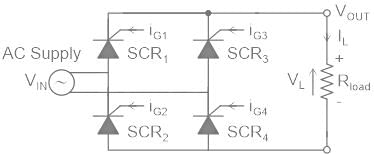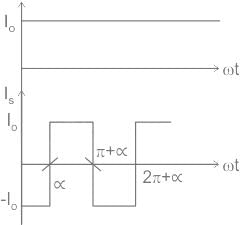Electrical Engineering (EE) Exam > Electrical Engineering (EE) Questions > A single-phase diode bridge rectifier is used...
Start Learning for Free
A single-phase diode bridge rectifier is used to supply a highly inductive load. If the load current is assumed to be ripple free, then the input current at the ac side of the rectifier will be
- a)Square wave
- b)Purely sinusoidal
- c)Pure DC
- d)Triangular wave
Correct answer is option 'A'. Can you explain this answer?
Most Upvoted Answer
A single-phase diode bridge rectifier is used to supply a highly induc...
1ϕ full wave rectifier:

Case 1: α < ωt < π + α

Case 1: α < ωt < π + α
SCR1 and SCR4 conduct.
Vo = Vs
Io = Is
Case 2: π + α < ωt < 2π + α
SCR2 and SCR3 conduct.
Vo = - Vs
Is = - Io


Free Test
FREE
| Start Free Test |
Community Answer
A single-phase diode bridge rectifier is used to supply a highly induc...
Understanding the Diode Bridge Rectifier
A single-phase diode bridge rectifier is essential in converting alternating current (AC) to direct current (DC). When connected to a highly inductive load, the behavior of the input current differs from typical rectifier operations.
Input Current Waveform Characteristics
- Inductive Load Impact: In a highly inductive load scenario, the current drawn from the AC source does not follow the simple charging and discharging pattern typical of resistive loads. Instead, the inductor smooths out the variations in current, leading to a consistent DC output.
- Current Shape: The output of the rectifier is a pulsating DC, but when viewed at the AC side, due to the nature of the diode operation (only allowing current to flow during the positive half-cycles of the AC waveform), the input current will not be a pure sinusoidal wave.
Square Wave Generation
- Rectification Process: The diode bridge conducts current when the AC input voltage is positive, leading to a current waveform that effectively resembles a square wave.
- Zero Current Regions: During the negative half-cycle of the AC input, the diodes block the flow of current, resulting in zero current. This alternation between conducting and non-conducting states generates a square-like waveform.
Conclusion
Hence, the input current at the AC side of the rectifier appears as a square wave due to the conduction characteristics of the diodes combined with the smoothing effect of the inductive load. Thus, the correct answer is option 'A'.
A single-phase diode bridge rectifier is essential in converting alternating current (AC) to direct current (DC). When connected to a highly inductive load, the behavior of the input current differs from typical rectifier operations.
Input Current Waveform Characteristics
- Inductive Load Impact: In a highly inductive load scenario, the current drawn from the AC source does not follow the simple charging and discharging pattern typical of resistive loads. Instead, the inductor smooths out the variations in current, leading to a consistent DC output.
- Current Shape: The output of the rectifier is a pulsating DC, but when viewed at the AC side, due to the nature of the diode operation (only allowing current to flow during the positive half-cycles of the AC waveform), the input current will not be a pure sinusoidal wave.
Square Wave Generation
- Rectification Process: The diode bridge conducts current when the AC input voltage is positive, leading to a current waveform that effectively resembles a square wave.
- Zero Current Regions: During the negative half-cycle of the AC input, the diodes block the flow of current, resulting in zero current. This alternation between conducting and non-conducting states generates a square-like waveform.
Conclusion
Hence, the input current at the AC side of the rectifier appears as a square wave due to the conduction characteristics of the diodes combined with the smoothing effect of the inductive load. Thus, the correct answer is option 'A'.

|
Explore Courses for Electrical Engineering (EE) exam
|

|
Question Description
A single-phase diode bridge rectifier is used to supply a highly inductive load. If the load current is assumed to be ripple free, then the input current at the ac side of the rectifier will bea)Square waveb)Purely sinusoidalc)Pure DCd)Triangular waveCorrect answer is option 'A'. Can you explain this answer? for Electrical Engineering (EE) 2025 is part of Electrical Engineering (EE) preparation. The Question and answers have been prepared according to the Electrical Engineering (EE) exam syllabus. Information about A single-phase diode bridge rectifier is used to supply a highly inductive load. If the load current is assumed to be ripple free, then the input current at the ac side of the rectifier will bea)Square waveb)Purely sinusoidalc)Pure DCd)Triangular waveCorrect answer is option 'A'. Can you explain this answer? covers all topics & solutions for Electrical Engineering (EE) 2025 Exam. Find important definitions, questions, meanings, examples, exercises and tests below for A single-phase diode bridge rectifier is used to supply a highly inductive load. If the load current is assumed to be ripple free, then the input current at the ac side of the rectifier will bea)Square waveb)Purely sinusoidalc)Pure DCd)Triangular waveCorrect answer is option 'A'. Can you explain this answer?.
A single-phase diode bridge rectifier is used to supply a highly inductive load. If the load current is assumed to be ripple free, then the input current at the ac side of the rectifier will bea)Square waveb)Purely sinusoidalc)Pure DCd)Triangular waveCorrect answer is option 'A'. Can you explain this answer? for Electrical Engineering (EE) 2025 is part of Electrical Engineering (EE) preparation. The Question and answers have been prepared according to the Electrical Engineering (EE) exam syllabus. Information about A single-phase diode bridge rectifier is used to supply a highly inductive load. If the load current is assumed to be ripple free, then the input current at the ac side of the rectifier will bea)Square waveb)Purely sinusoidalc)Pure DCd)Triangular waveCorrect answer is option 'A'. Can you explain this answer? covers all topics & solutions for Electrical Engineering (EE) 2025 Exam. Find important definitions, questions, meanings, examples, exercises and tests below for A single-phase diode bridge rectifier is used to supply a highly inductive load. If the load current is assumed to be ripple free, then the input current at the ac side of the rectifier will bea)Square waveb)Purely sinusoidalc)Pure DCd)Triangular waveCorrect answer is option 'A'. Can you explain this answer?.
Solutions for A single-phase diode bridge rectifier is used to supply a highly inductive load. If the load current is assumed to be ripple free, then the input current at the ac side of the rectifier will bea)Square waveb)Purely sinusoidalc)Pure DCd)Triangular waveCorrect answer is option 'A'. Can you explain this answer? in English & in Hindi are available as part of our courses for Electrical Engineering (EE).
Download more important topics, notes, lectures and mock test series for Electrical Engineering (EE) Exam by signing up for free.
Here you can find the meaning of A single-phase diode bridge rectifier is used to supply a highly inductive load. If the load current is assumed to be ripple free, then the input current at the ac side of the rectifier will bea)Square waveb)Purely sinusoidalc)Pure DCd)Triangular waveCorrect answer is option 'A'. Can you explain this answer? defined & explained in the simplest way possible. Besides giving the explanation of
A single-phase diode bridge rectifier is used to supply a highly inductive load. If the load current is assumed to be ripple free, then the input current at the ac side of the rectifier will bea)Square waveb)Purely sinusoidalc)Pure DCd)Triangular waveCorrect answer is option 'A'. Can you explain this answer?, a detailed solution for A single-phase diode bridge rectifier is used to supply a highly inductive load. If the load current is assumed to be ripple free, then the input current at the ac side of the rectifier will bea)Square waveb)Purely sinusoidalc)Pure DCd)Triangular waveCorrect answer is option 'A'. Can you explain this answer? has been provided alongside types of A single-phase diode bridge rectifier is used to supply a highly inductive load. If the load current is assumed to be ripple free, then the input current at the ac side of the rectifier will bea)Square waveb)Purely sinusoidalc)Pure DCd)Triangular waveCorrect answer is option 'A'. Can you explain this answer? theory, EduRev gives you an
ample number of questions to practice A single-phase diode bridge rectifier is used to supply a highly inductive load. If the load current is assumed to be ripple free, then the input current at the ac side of the rectifier will bea)Square waveb)Purely sinusoidalc)Pure DCd)Triangular waveCorrect answer is option 'A'. Can you explain this answer? tests, examples and also practice Electrical Engineering (EE) tests.

|
Explore Courses for Electrical Engineering (EE) exam
|

|
Signup for Free!
Signup to see your scores go up within 7 days! Learn & Practice with 1000+ FREE Notes, Videos & Tests.























